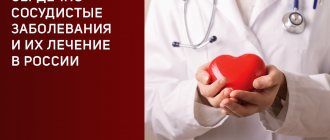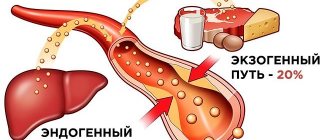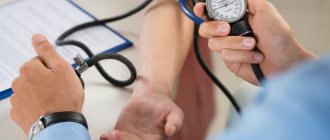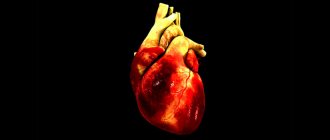All about cholesterol
Svetlana Filippovna, so what is cholesterol and how necessary is it for the body?
As such, cholesterol is a water-insoluble alcohol and is just as necessary for the body as carbohydrates, since cells use cholesterol to build membranes and produce hormones, bile acids and vitamin D3 from it.
The problem only arises when there is an excess of it. How does cholesterol get into our body?
Cholesterol is found in products of animal origin, so advertisements shouting that “there is no cholesterol in our sunflower oil” can be ignored - it cannot be there a priori.
But it must be said that the body absorbs from what we eat, God forbid 10%! The liver itself synthesizes cholesterol, about 80%. She needs him! After all, with its help, red blood cells, platelets, and connective tissues are renewed. Sometimes a high cholesterol level can suggest a tumor formation, because as it grows, the body begins to synthesize a very large amount of cholesterol, since cholesterol is the builder of even such tissue. What level of cholesterol is harmful to the body?
The thing is that cholesterol combines in the blood with high and low density lipoproteins.
High-density lipoproteins, combining with cholesterol, are transferred to the liver and are safely processed there, but low-density lipoproteins, together with cholesterol, are transported into the vessels and have a damaging effect on the endothelium of the vascular wall. It turns out that high cholesterol is not good for the body. In general, everyone has their own individual cholesterol level; it is impossible to classify everyone into groups, since everyone has a different metabolism, so treatment, if necessary, is prescribed only after a full examination. After all, a person may also have congenital problems. Let me give you an example. Cholesterol is transported by a transport protein, which is part of low-density lipoprotein, and in this transport protein, let’s say, there is some kind of genetic defect, which means it will not be transferred there at the speed that is necessary, which means it will not build this membrane as needed , since he does not build this membrane as needed, all this will accumulate in the body. In this case, by a certain age this can lead to the most disastrous results. Everyone should understand that they need to be very wary of cholesterol and monitor its level. If a person has high cholesterol levels, he should not remain indifferent to this fact and should not ignore it. If it is elevated, doctors usually prescribe statins. What are statins? Let's imagine a substance from which cholesterol begins to form - 22 reactions will take place before it is finally formed, and statins act on the enzyme at the very beginning, thereby destroying cholesterol. Does low cholesterol affect the body?
A good question and at the same time a difficult one.
Low cholesterol significantly increases the risk of death in older people. Scientists from the University of Hawaii came to this conclusion. So far, scientists cannot explain the data obtained. However, it is already clear that caution should be exercised in the fight against cholesterol in older people. Is high cholesterol dangerous for those who are young?
The first signs of atherosclerosis can already be detected at the age of 25-30. In addition, cholesterol metabolism disorders can be congenital.
And then constant monitoring of its level is necessary. Maintaining normal cholesterol levels is one of the main ways to prevent heart disease. This position in cardiology remains in force today. Svetlana Filippovna, so what is the potential weapon against cholesterol?
Monitor your body weight. The fatter you are, the more cholesterol your body produces. Taking vitamins C, E, and calcium significantly increases the level of high-density lipids. Don't forget about tea, rice and oat bran.
Risk factors for cardiovascular disease
Risk factors are not the cause of the disease. Risk factors are external influences and internal characteristics of the body that contribute to the development of the disease. There are modifiable factors - those that a person can change. And unmodifiable, which cannot be influenced.
| Modifiable risk factors | Non-modifiable risk factors |
|
|
In recent years, increasing attention has been paid to psychological factors. Anxiety, social isolation, depression and low levels of social support have an adverse effect on the formation and progression of cardiovascular diseases.
Attention! Homocysteine!
Recently there has been a lot of talk about homocysteine and especially about its role in the development of atherosclerosis. What kind of homocysteine is this?
We can say that cholesterol now has a competitor - homocysteine.
Unlike cholesterol, it is not found in foods, but is formed in our body from the essential amino acid methionine. Homocysteine increases with a lack of B vitamins and folic acid. But an excess of it in the body creates problems: it is the first to penetrate the endothelium (wall) of blood vessels and damage it, and only then does cholesterol get to work. What factors, besides a lack of vitamins, contribute to an increase in homocysteine?
These are genetic factors caused by enzyme pathology.
In this regard, homocysteine metabolism is disrupted and its level increases. We must not forget about patients whose kidney function is impaired with age, since homocysteine is excreted mainly by the kidneys. What effect does high homocysteine have on the body?
In addition to a marker of vitamin deficiency, its high level affects the coagulation system, creating the preconditions for the occurrence of a thrombotic state, inhibiting the work of the anticoagulant system.
A vicious circle arises of a wide variety of relationships between homocysteine and the coagulation system, which subsequently requires careful clinical and laboratory examination. Agree that homocysteine is not so simple! Tell me, are there any standards for homocysteine levels in the blood?
Due to the fact that even small amounts of homocysteine can have a fairly strong effect on blood vessels, there is practically no standard. After all, its concentration in the blood is 1000 times less than cholesterol, and the harm is almost as many times greater. Although, of course, there are laboratory standards.
What is cholesterol
Cholesterol is an organic compound, a component of cell membranes.
Its name comes from the Greek words “chole” (bile) and “stereo” (solid). The chemical structure of cholesterol is a polycyclic lipophilic alcohol. The endings “sterol” and “sterol” are synonyms meaning they belong to steroids, so cholesterol and cholesterol mean the same compound. Cholesterol is especially high in brain tissue, the nervous system, adipose tissue and bile. Only a fifth of it enters the body with food (meat and offal, fish, eggs, dairy products), and the main amount is formed in the liver, kidneys, intestines, adrenal glands and gonads.
The liver also receives cholesterol from food and is the main storage site for this compound. Cholesterol is transported through the blood by special transport complexes - lipoproteins. In this case, low-density lipoproteins transport it from the liver to the tissues, and high-density lipoproteins transport it in the opposite direction, that is, to the liver.
Let's think about diagnostics
Since we were talking about problems of the coagulation system, what laboratory parameters should the patient pay attention to first?
For prothrombin index, thrombin and platelets. If these indicators are within the normal range, then you can move on with your life, and if not, then together with the clinician try to analyze what this could be connected with. Homocysteine has one feature - it inhibits the effect of a natural anticoagulant (antithrombin - III), thereby promoting an increase in thrombin in the blood and activating coagulation processes. But whether this will lead to a thrombotic state needs to be analyzed further. In general, any patient, especially over 45-50 years old, should be interested in a detailed laboratory examination, as well as timely determination of blood cholesterol levels. At the multidisciplinary CELT Clinic you can always undergo all the necessary examinations. Using the most modern extended scheme, we can fully present you with the full spectrum of lipid profile, which includes: cholesterol, low-density lipids, high-density lipids, apolyproteins, and you can always find out the level of homocysteine. I remind you that these biochemical tests should be taken on an empty stomach, preferably in the morning; you will receive the tests the very next day. I wish everyone good health and good blood counts. Don't joke with them, show them some attention and you will live to be 100 years old!
The principle of cholesterol formation
About 80% of all cholesterol is produced by liver cells. About 2.5 g of it is synthesized per day, and 0.5 g comes from animal products. Biosynthesis takes place through 30 sequential reactions. The raw materials for education are fats, glucose and amino acids.
Regulation of the rate of cholesterol formation occurs according to the feedback principle - the more cholesterol in the blood, the less it is formed and vice versa. Also, insulin and thyroid hormones inhibit the production of cholesterol, while glucagon and adrenal hormones stimulate it.
Banal diet: down with trans fats, give me avocados!
Saturated and trans fats that are harmful in this case are found in fatty meats and fatty dairy products. Their consumption should be limited to moderation. It would be good to replace these foods with sources of polyunsaturated fats. It is also worth limiting the consumption of confectionery products and not overusing egg yolks (no more than 2 per week).
Recommended foods:
- vegetable oils;
- fatty fish (salmon, tuna, mackerel);
- avocados and almonds;
- fresh garlic (2-3 cloves with food);
- fruits, vegetables and legumes in the amount of 5 servings per day.
Biotransformation of cholesterol
Biotransformation (conversion) into bile acids is the main stage in the metabolism and removal of cholesterol from the body. Bile acids are necessary for:
- digestion of fats (emulsify, transform into a soluble state);
- activation of digestive enzymes of the pancreas;
- absorption of fats in the intestines.
Primary fatty acids (cholic and chenodeoxycholic) are formed in the liver. They enter the bile capillaries from hepatocytes, accumulate in the gallbladder and are released into the duodenum when eating. Enzymes of beneficial intestinal microorganisms convert primary bile acids into deoxycholic and lithocholic acids.
Primary and secondary bile acids are involved in the digestion of fats, then the main amount (about 98-99%) returns back to the liver through the portal vein system. A small amount of bile acids is excreted in the feces, this is the main way to remove cholesterol from the body. To replace the excreted bile acids, new ones are formed from cholesterol reserves.
Less significant (in terms of quantity) processes of cholesterol biotransformation include its conversion into hormones and vitamin D.
A healthy lifestyle: losing excess weight, regular exercise, and a low-fat diet eliminate cholesterol metabolism disorders. However, if positive lifestyle changes do not have a significant effect on LDL or VLDL levels, your doctor will prescribe cholesterol-lowering medications.
Biological role of cholesterol in the body
Cholesterol is involved in many biological processes in the body:
- gives strength to cell membranes;
- creates a protective sheath for nerve fibers (part of myelin);
- “repairs” damage to the inner wall of blood vessels (“puts a patch”);
- participates in the formation of steroid hormones - the adrenal cortex (corticosteroids), male and female sex hormones (estrogens, progesterone, testosterone);
- in the skin, vitamin D is formed from it under the influence of ultraviolet rays;
- Bile acids are synthesized from cholesterol in the liver.
Complexes with this research
Monitoring of diabetes Monitoring of the condition of patients with diabetes (once every 6 months) 1,900 ₽ Composition
Expanded hospital complex Expanded infectious screening for prevention and hospitalization 5,030 ₽ Composition
Liver and pancreas Diagnosis of possible liver pathologies at an early stage 1,810 ₽ Composition
IN OTHER COMPLEXES
- Joining IVF RUB 16,850
- Biochemistry of blood. 13 indicators 2,460 ₽
- Examination during pregnancy. 3rd trimester 6,430 RUR
- Pregnancy planning. Clinical indicators RUB 4,310
- Biochemistry of blood. 19 indicators 4,040 ₽
Consequences of excess cholesterol in the blood
Cholesterol metabolism (metabolism) disorders were previously considered the main cause of atherosclerosis. Doctors pay special attention to increasing total blood cholesterol, triglycerides and low-density lipoproteins. A decrease in high-density lipoproteins is also taken into account. To do this, a blood test is performed to determine lipid metabolism indicators (total cholesterol, triglycerides, HDL, LDL, VLDL).
Currently, excess cholesterol in the blood is undoubtedly a risk factor, but there are cases of the development of atherosclerosis even with a normal amount of this lipophilic alcohol in the blood. It is important to take into account other provoking pathologies: diabetes, obesity, hypertension, damage to the vascular wall, as well as physical inactivity (lack of movement), smoking, age, male gender, heredity, etc.
Under the influence of several of these factors, cholesterol is deposited in the wall of blood vessels and an atherosclerotic plaque is formed. Because of this, the walls of blood vessels thicken and lose elasticity, the lumen of the vessel narrows, and blood flow is obstructed. This causes disruption of organ nutrition. When the arteries of the heart are blocked, a heart attack develops, in the cerebral arteries - an ischemic stroke, and in the arteries of the extremities - gangrene.





